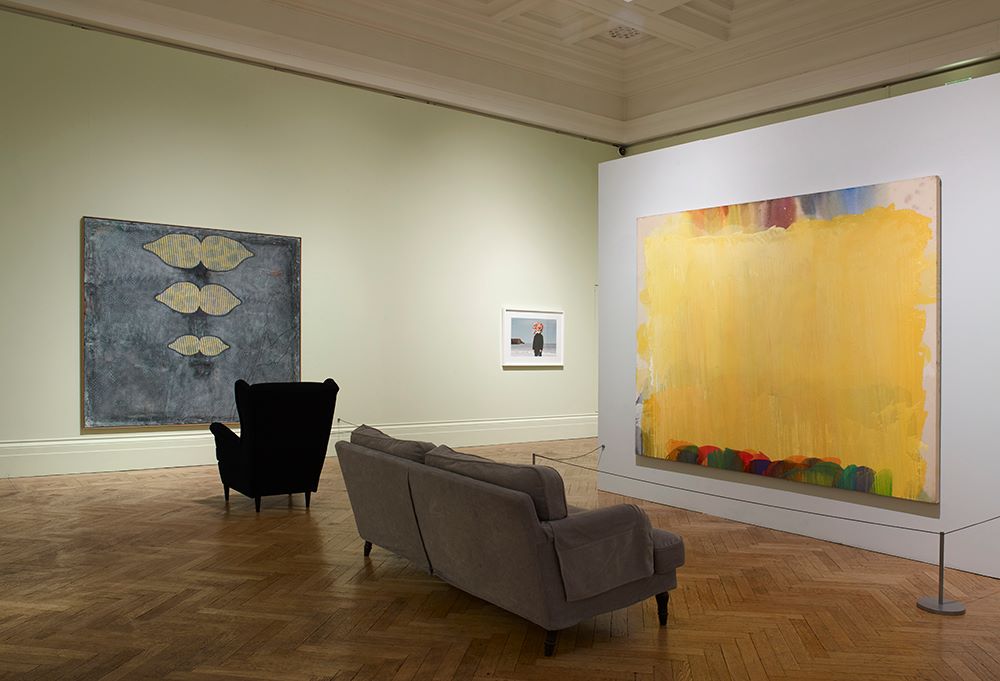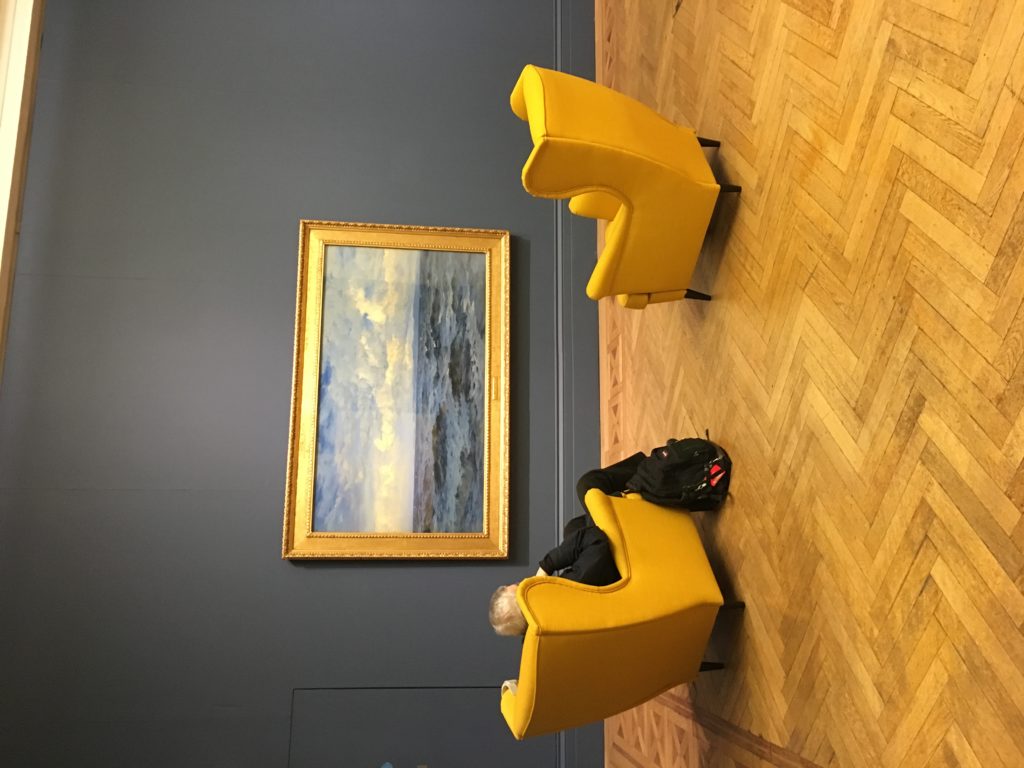
‘And Breathe…’ installation view c. Manchester Art Gallery (2018)
Museums, as gatekeepers of national collections, can be argued to problematise public access and experience. This is made apparent even more in a digital age, where information is mobilised and a museum’s fixed geographic location and public perception as a space of authority could be perceived as increasingly out of touch with the issues present in today’s society. Community led projects with the aim of creating an immersive and participatory space within an institution are a way forward to bridge this gap and benefit visitor engagement. Within this text I will explore these topics critically with a view to argue that the new dynamic space created through community collaboration in the museum needs to be durational and not just project based.
In an overview of various key academic texts that critique the museum at it’s worst as the ‘Death of Experience’ and at it’s best as a precarious space for visitors to experience culture, Hetherington (2014) suggests three main points of complication: singularity (when a museum is understood as a sacred space that serves to decontextualise collections through ordering them); interiority (the collections being only narrated from within the museum’s walls) and finally the outside (the idea of the space of ‘otherness’ and it’s absence in a museum’s archive). Whereas singularity and interiority are barriers museums are making attempts to broach, Hetherington suggests that the third point, the outside or ‘other’, should be further recognised by museums when looking at engaging visitor experience.
What is problematic is the idea of a disorderly outside that might impinge upon the archive and challenge not its representation of an order but its very principle as an ordering device. (Hetherington, 2014, p. 79)
Kidd (2014) also acknowledges that museums have an embedded cultural understanding of experience but suggests that the boundaries of museums are changing through networking and adopting more participatory approaches. Here they suggest the potential for the museum to be a Transmedia storyteller – experimental, playful and unfinished and that a museum encounter should narrate across different platforms to ‘spill over into the everyday’ (Kidd, 2014, p. 23). Although highlighting online exhibition’s potential to make the museum more immersive Kidd argues to not move the museum’s space online, as virtual galleries replace physical relationships with material culture. Instead Kidd promotes interactivity as the way forward and notions that museums should instead push to motivate audiences to experience their collections in new ways.
Waterton and Watson (2013, p. 558) advise ‘decentring heritage’ by looking for connections with lived experience. On the other hand, Stern and Seifert (2016, p. 278) promote that the value of cultural engagement is impeded with the experiences of visitors and note the restriction of ‘the reflective individual’, suggesting that we need to go further to also focus on the neighbourhood complex. Dawes (2008) maintains that integrating local communities, particularly young people, serves to strengthen public engagement through a sense of ownership with art and argues that these short term projects should not have a finish and end point but always be part of a process.
‘Rather than asking ‘them’, shouldn’t we be trying to dissolve boundaries and distinctions between them and everyone else? While it may be a sign of progress that cultural professionals are now paying attention to ‘their’ aspirations – what ‘the people’ want – shouldn’t we now be reaching beyond that to what we want as communities?’ (Dawes, 2008, p. 56)
An example of a recent museum collaboration that hopes to achieve this goal is perhaps the best way to complete this thematic analysis. And Breathe… is a recurring art exhibition at Manchester Art Gallery that co-curates with local communities to intercede into the traditional gallery space in order to heighten wellbeing, offering visitors a personal connection to artworks through the promotion of mindfulness. The exhibition is not a narration the gallery has put on internally, but is instead an interdisciplinary partnership working to use the gallery’s collections to engage with current societal pressures such as anxiety and depression and promote an improvement to a visitor’s mental health.

‘And Breathe…’ installation view c. Manchester Art Gallery/Photograph by Author (2018)

‘And Breathe…’ exhibition label c. Manchester Art Gallery/Photograph by Author (2018)
The version I visited and will be using as an example ran from March 2018 – September 2019. This version was delivered in partnership with local mental health organisations Start and Manchester Mind and Year 5 and 6 pupils from Charlestown Community Primary School. It is interesting how only minor changes made to the space, including colour scheme and inclusion of furniture, can make such a dramatic effect to engaging with an artwork due to the environment created around it. This was enhanced through an audio guide that used a meditative approach, not telling visitors what the artwork is about but rather asking them to reflect on how it makes them feel, mirroring the exhibition’s catalogue statement that ‘There is no right or wrong way to engage with art’ (Manchester Art Gallery, 2018).
Importantly, this exhibition is a component of a greater partnership between Greater Manchester Mental Health Trust and Manchester Art Gallery, who have been working together since 2013 to create mindfulness activities across the gallery’s public programmes. It is an example of a programme that actively works in effective collaborations for the community to achieve the gallery’s strategic plan 2016-20 of ‘a warm welcome for all and a strong social conscience’ (Rahman, 2020).
In writing this thematic analysis it was my intention to explore reasons for why it should always be a community led endeavour when putting on exhibitions to bring the outside in and make the museum a more dynamic space for visitor engagement. Whilst the museum can act as a barrier, it’s surrounding community based networks have the potential to create immersive, participatory spaces that can be used to reflect the tensions in our current culture back on to us. And Breathe… and it’s larger body of programming, works to promote art as functional, socialised work within the wider community in connection to the museum’s physical and geographical location. I would argue that the possibility of a reworking of the archive from outside sources in this way should remain as a work in progress in order to continue to evolve and reflect the surrounding community’s key interests.
Dawes, M. (2008) ‘Beyond Process: Art, Empowerment and Sustainability’ in Coutts, G. and Jokela, T. (eds.) Art, community and environment: educational perspectives, Bristol: Intellect, pp. 55-64.
Hafeji, R. (2018) ‘And Breathe…’, The Mindful Museum at Manchester Art Gallery Available at: https://www.gmmh.nhs.uk/news/and-breathe-the-mindful-museum-at-manchester-art-gallery-2197/ (Accessed: 25 February 2020).
Hetherington, K. (2014) ‘Museums and the “Death of Experience: Singularity, Interiority and the Outside’, International Journal of Heritage Studies, 20(1), pp. 72–85. DOI: https://doi.org/10.1080/13527258.2012.710851.
Kidd, J. (2014) Museums in the New Mediascape: Transmedia, Participation, Ethics. Surrey: Ashgate Publishing Limited.
Manchester Art Gallery (2018) And Breathe… – Exhibition Booklet Available at: https://manchesterartgallery.org/wp-content/uploads/2018/01/MAG-And-Breathe…-Exhibition-Booklet.pdf (Accessed: 25 February 2020).
Manchester Art Gallery (2020) And Breathe… Available at: https://manchesterartgallery.org/exhibitions-and-events/exhibition/and-breathe/ (Accessed: 25 February 2020).
Manchester Art Gallery (2020) The Mindful Museum Available at: https://manchesterartgallery.org/learn/mindful-museum/ (Accessed: 25 February 2020).
Rahman, L. (2020) About Us – Manchester Art Gallery Available at: https://manchesterartgallery.org/visit/about-us/ (Accessed: 25 February 2020).
Stern, M. J. and Seifert, S. C. (2016) ‘Understanding the value of arts & culture: the AHRC cultural value project (2016) by Geoffrey Crossick and Patrycja Kaszynska’, Cultural Trends, pp. 25(4), pp. 277-279, DOI: 10.1080/09548963.2016.1241468.
Waterton, E. and Watson, S. (2013) ‘Framing Theory: Towards a Critical Imagination in Heritage Studies’, International Journal of Heritage Studies, 19(6), pp. 546–61. DOI: https://doi.org/10.1080/13527258.2013.779295.

Leave a Reply